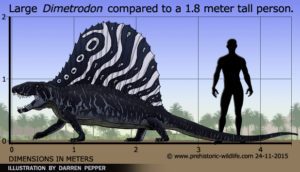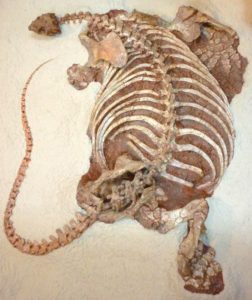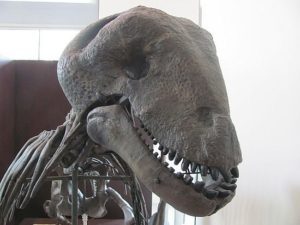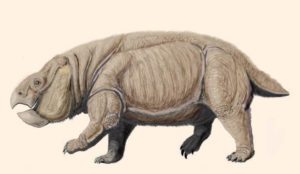Podcast: Play in new window | Download (Duration: 13:44 — 14.0MB)
What kinds of animals lived before dinosaurs evolved? What did they evolve into? Let’s find out!
Dimetrodon! Not a dinosaur! Not even actually a reptile:


Cotylorhynchus had a teeny head. I am not even exaggerating:


Moschops had a big thick skull:


Lisowicia was the size of an elephant but looked like…well, not like an elephant:


Show transcript:
Welcome to Strange Animals Podcast. I’m your host, Kate Shaw.
Lots of people know about dinosaurs. Dinosaurs are really interesting. But do you know what animals lived before dinosaurs evolved? Let’s find out.
If you’ve heard of dimetrodon, you may think it’s just another dinosaur. It’s the animal that looks sort of like a huge lizard with a sail-like frill down its back. But not only was dimetrodon not a dinosaur, it went extinct 40 million years before the first dinosaur evolved.
Dimetrodon lived almost 300 million years ago and was a synapsid. Synapsid is a catchall term for a group of animals with both reptilian and mammalian characteristics, also sometimes called proto-mammals. The term synapsid also includes mammals, so yes, you are related to dimetrodon verrrrrrry distantly. You are more closely related to dimetrodon than you are to any dinosaur, let’s put it that way. Dimetrodon was an early synapsid, which are referred to as pelycosaurs.
The largest species of dimetrodon grew up to 15 feet long, or 4.6 meters, with some probably growing even larger. It had serrated teeth, a long tail, short legs, and a massive sail on its back. The sail is formed from neural spines, which are basically just really long prongs of bone growing from the vertebrae. The spines were connected with webbing, although possibly not all the way to the tip of the spines. Ever since the first fossil remains of dimetrodon were discovered in 1878, scientists have been trying to figure out what the sail was for.
For a long time the most popular theory was that the sail helped with thermoregulation. That is, it helped dimetrodon stay warm in cool weather and cool in warm weather by absorbing sunshine or releasing heat, depending on where dimetrodon was. If dimetrodon was chilly, it would angle its body so that lots of sunlight reached its sail, but if dimetrodon was hot, it would find a patch of shade or turn its body so that minimal sunlight reached its sail, allowing the blood vessels covering the sail to release heat into the atmosphere.
This is a pretty good guess, since many modern animals use something similar to help regulate body temperature. That’s why African elephants have such large ears. But more recent studies of dimetrodon’s sail show that it didn’t have a lot of blood vessels, as it would if it was for thermoregulation. These days paleontologists suggest the sails may have mostly been for display. Different species had differently shaped sails, and there’s some evidence that male and female dimetrodons of the same species may have had differently shaped sails too. It’s possible the sails were brightly colored or patterned during the breeding season.
But dimetrodon wasn’t the only early synapsid with a sail. Secodontosaurus had one too and resembled dimetrodon in many ways, including having a long tail and short legs. But where dimetrodon was chunky with a massive skull, secodontosaurus was much more slender with long, narrow jaws. It may have eaten fish. It probably grew up to nine feet long, or 2.7 meters, and it lived around 275 million years ago. It was related to dimetrodon, but paleontologists aren’t sure how closely it was related.
The largest pelycosaur, or early synapsid, was cotylorhynchus [ko-tillo-rinkus], which lived around 275 million years ago in what is now North America. It was a weird-looking animal. Weird, weird weird. Seriously, it was very strange. It grew to almost twenty feet long, or 6 meters, with a barrel-shaped body, great big legs, and a long tail. But its neck was very short and its head was tiny.
Some researchers think cotylorhynchus lived in the water. Its forefeet may have been paddle-shaped. It ate plants, which is why its body was so big, since it needed room to hold lots of plants while they digested. It may have dug for roots as well, since its forefeet had long claws. Weird as it was, if you think of it as shaped sort of like a giant tortoise, its small head and big body make more sense.
Dimetrodon and other pelycosaurs lived in the early Permian era. By the mid-Permian, a group of synapsids called therapsids started evolving to become more mammal-like. The legs of therapsids were positioned more beneath the body instead of sprouting out from the sides, which is the difference between a dog’s body and a lizard’s body. This allowed therapsids to run more efficiently and breathe more efficiently when moving fast.
We know that at least some of these early therapsids had fur because paleontologists have found coprolites, which as you recall are fossilized poops, with fur embedded in them. Since this was long before mammals evolved, it had to be therapsids with fur. In fact, it was the therapsids that eventually evolved into mammals, so technically you are also a therapsid.
Therapsids were probably warm-blooded and probably had whiskers. But they wouldn’t have looked like mammals today. They probably resembled reptiles in a lot of ways, especially early therapsids. The tails of many therapsids would have looked like reptile tails, long, thick, and pointed. The heads would have looked much more like a lizard head than a mammal head, with no external ears.
Some therapsids would have looked really weird. For instance, moschops [mo-shops], which lived around 260 million years ago in what is now southern Africa. Moschops was a type of therapsid that ate plants, and it was massively built. It was around 8 feet long, or 2.5 meters, and had a thick skull and short snout with strong jaw muscles. The back sloped downward from the shoulders to a short tail. Its relatively short legs were sturdy to hold up the weight of the broad and massive body. The front legs were much farther apart than the hind legs. Its teeth were strong but not sharp; instead, they had chisel-like edges that helped it bite through tough vegetation.
Moschops had such a thick skull that many researchers think it fought other moschopses by butting heads. The small brain was extremely well protected by a skull that was as much as 6 inches thick, or 15 cm, and new research shows that the head was usually held forward instead of up. This makes sense in a grazing animal, and would also make sense if males were butting heads to impress potential mates, or if individuals fought over territory or food. If moschops did butt heads, it’s possible that it lived in groups with a certain amount of social organization.
Toward the end of the Permian, a group of therapsids called dicynodonts became widespread and lived well into the Triassic era. Dicynodonts were probably warm-blooded, probably had fur or hair, and some may have had feet that were more paw-like than reptilian, with fleshy pads. But while all these features are mammalian, most dicynodonts had a horny beak like a turtle and either no teeth at all, or only a pair of teeth in the front of the jaw that grew like tusks. Some paleontologists think only males had these tusks. Most dicynodonts were herbivorous and some dug burrows.
About 250 million years ago, there was a mass extinction event called the Permian-Triassic extinction, or sometimes just the Great Dying. Researchers aren’t sure what caused it, but like the later extinction that ended the dinosaurs, it may have been caused initially by a massive meteor impact that sent the earth’s climate into a tailspin. 96% of all marine species went extinct and 70% of land animals. This was the event that led to the rise of the dinosaurs ultimately. But some therapsids survived.
The biggest dicynodont evolved after the great dying and it was the size of an elephant. Lisowicia lived in what is now Poland around 230 million years ago, but it was probably more widespread than that sounds. We only have a single specimen of lisowicia that was discovered in south Poland in 2008. It probably stood 8 ½ feet high, or 2.6 meters. All four of its legs were positioned under the body like modern mammals, whereas most dicynodonts were similar to moschops, where the hind legs were under the body and the forelegs were more widely spaced and sprawling. But it probably didn’t look much like a modern mammal beyond that. Its head would probably have looked quite reptilian since it had a horny beak like other dicynodonts. Its tail was short.
Dicynodonts went extinct by the late Triassic, but the related cynodonts persisted. Cynodonts are the direct ancestors of mammals. You are definitely also considered a cynodont. The first cynodonts evolved in the late Permian and had a lot of traits that are still retained by mammals, such as fur, whiskers, warm-bloodedness, and teeth that are differentiated into different types like molars and incisors. They also developed what’s called a secondary palate, or as we call it, the roof of the mouth. All mammals still have this feature, which allows us to breathe and chew at the same time. But cynodonts also still probably laid eggs. Eventually cynodonts developed into monotremes like the platypus and echidna, which many researchers consider to retain many cynodont features.
Probably the largest cynodont was cynognathus, which lived around 240 million years ago. Cynognathus was a predator that grew almost four feet long, or 1.2 meters, not counting its long tail. It was widespread throughout the southern hemisphere, with cynognathus fossils of various species found in modern-day southern Africa, South America, and Antarctica. It had already evolved the secondary palate, and its head and jaws were both long and wide, with sharp teeth.
Because cynodonts lived alongside dinosaurs for millions of years, they evolved into animals that were generally quite small, no larger than a rat, and frequently nocturnal. But they were still incredibly successful, spreading out across the world and evolving into animals that looked more and more like mammals that we’d recognize today. The haramiyids were probably insectivores and lived in trees, with some species able to glide like flying squirrels or the colugo. Many cynodonts lived in large shared burrows, suggesting increasingly complex social behavior.
But not all early mammals were tiny and ran away from dinosaurs. Repenomamus [re-penno-may-mus] lived around 125 million years ago and grew over three feet long, or 1 meter. In shape, it somewhat resembled a badger with a long tail. We know it ate small animals, including hatchling dinosaurs, because fossil remains of a baby psittacosaurus [sit-acko-saurus] was found in the stomach area of a fossil repenomamus. The psittacosaurus remains were in chunks, which suggests that repenomamus had bitten it into pieces to swallow it.
Repenomamus was considered a Eutriconodont, a type of early mammal, but the eutriconodonts went extinct at about the same time as the dinosaurs.
But by then, the therapsids were fully evolved into what we have termed mammals. And they were poised to take over. Or, I should say, we mammals were poised to take over. And we have.
You can find Strange Animals Podcast online at strangeanimalspodcast.com. We’re on Twitter at strangebeasties and have a facebook page at facebook.com/strangeanimalspodcast. If you have questions, comments, or suggestions for future episodes, email us at strangeanimalspodcast@gmail.com. We also have a Patreon if you’d like to support us that way.
Thanks for listening!